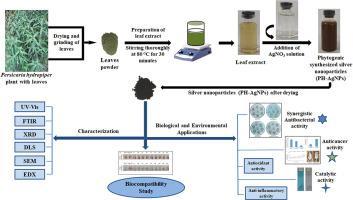Green synthesis of biocompatible silver nanoparticles from Persicaria hydropiper leaves: Therapeutic and catalytic applications
IF 5.1
Q1 CHEMISTRY, APPLIED
引用次数: 0
Abstract
The study presents a sustainable method for synthesizing biocompatible silver nanoparticles from Persicaria hydropiper leaves (PH-AgNPs) with promising anti-inflammatory, antioxidant, anticancer, antimicrobial, and catalytic potentials. UV–vis analysis confirmed PH-AgNPs formation with a surface plasmon resonance (SPR) peak at 455 nm. FTIR spectra revealed the constituents of leaf extract involved in silver ion reduction. Characterization of PH-AgNPs was done using X-ray diffraction, dynamic light scattering, scanning electron microscopy, and energy dispersive X-ray techniques. This characterization confirmed that PH-AgNPs exhibited a crystalline, spherical shape with a strong silver peak. PH-AgNPs showed blood compatibility and a non-toxic nature as compared with Triton-X. PH-AgNPs exhibited moderate anti-inflammatory and antioxidant activities compared to diclofenac sodium and ascorbic acid. PH-AgNPs also showed potential as catalysts for the degradation of harmful dyes. In the anticancer experiment, PH-AgNPs treatments significantly (p < 0.05) decreased viable EAC (Ehrlich Ascites Carcinoma) cells and lowered weight gain in mice. PH-AgNPs (p < 0.05) restored blood counts and improved liver structure in treated mice versus untreated controls. Proapoptotic genes encoding p53 and Bax proteins were overexpressed in treated EAC cells, confirming the apoptotic hallmarks seen in fluorescence microscope images of these treated cells. PH-AgNPs demonstrated potent antibacterial activity, particularly against Shigella boydii, while erythromycin was the most effective against the same bacterium. PH-AgNPs combined with tetracycline showed the highest synergistic effect (37.26 %) against Escherichia coli. PH-AgNPs showed the lowest minimum inhibitory concentration (9.38 mg/mL) against Bacillus cereus. Therefore, the green-fabricated PH-AgNPs hold significant biological and environmental importance, offering potential for therapeutic and environmentally friendly applications.

绿色合成生物相容性银纳米粒子从水仙桃叶:治疗和催化应用
该研究提出了一种可持续的方法来合成具有抗炎、抗氧化、抗癌、抗菌和催化潜力的生物相容性银纳米颗粒。紫外-可见分析证实了PH-AgNPs的形成,表面等离子体共振(SPR)峰在455nm处。FTIR光谱揭示了叶提取物参与银离子还原的成分。通过x射线衍射、动态光散射、扫描电子显微镜和能量色散x射线技术对PH-AgNPs进行了表征。这一表征证实了PH-AgNPs呈现出具有强银峰的结晶球形。与Triton-X相比,PH-AgNPs具有血液相容性和无毒性。与双氯芬酸钠和抗坏血酸相比,PH-AgNPs表现出中等的抗炎和抗氧化活性。PH-AgNPs还显示出作为降解有害染料催化剂的潜力。在抗癌实验中,PH-AgNPs处理显著(p < 0.05)降低了小鼠的EAC(埃利希腹水癌)活细胞,降低了小鼠的体重增加。PH-AgNPs (p < 0.05)恢复了治疗小鼠的血细胞计数,改善了肝脏结构。编码p53和Bax蛋白的促凋亡基因在处理过的EAC细胞中过度表达,证实了这些处理过的细胞的荧光显微镜图像中所见的凋亡特征。PH-AgNPs显示出强大的抗菌活性,特别是对博伊地志贺氏菌,而红霉素对同一细菌最有效。PH-AgNPs联合四环素对大肠杆菌的增效效果最高(37.26%)。PH-AgNPs对蜡样芽孢杆菌的最低抑菌浓度为9.38 mg/mL。因此,绿色制造的PH-AgNPs具有重要的生物学和环境意义,为治疗和环境友好应用提供了潜力。
本文章由计算机程序翻译,如有差异,请以英文原文为准。
求助全文
约1分钟内获得全文
求助全文

 求助内容:
求助内容: 应助结果提醒方式:
应助结果提醒方式:


